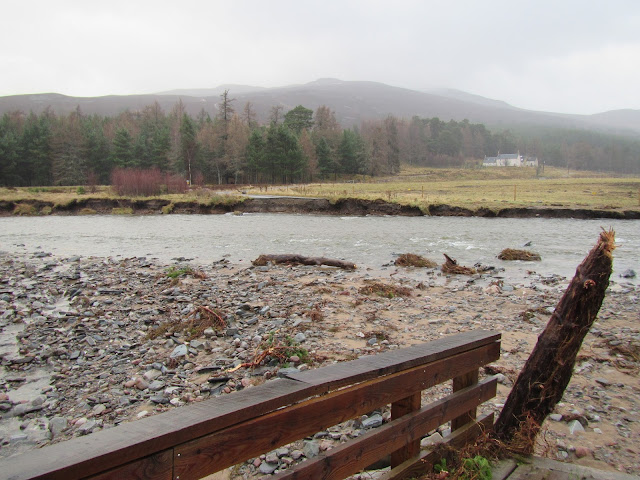In truth there isn't much to Kvikkjokk, a campsite, a heliport, a
church, a few houses and the Fjällstation
that's about all. Hard to imaging I'd just taken two days, three
flights, a two hour train and a four hour bus journey just to get
here. I stayed all of five minutes just long enough to send a quick
text home adjust my pack, get my bearings and go.
I started off on the Kungsleden a marked trail that threaded a way
through thick forest, well used and misused campsites just off the
path. From the thick forest into an open wooded area of bogs and
lakes, wide views of the hills ahead. The first river crossing, over
twenty in all, boots off running shoes on trousers rolled up. Still
higher a moorland zone dwarf willow and alder colourful flowers and
reindeer lots of reindeer. Another river this one a wild raging
torrent, a huge snow patch had bridged it but that had collapsed a
few day before. Took me all morning to walk to the tarn at it's head
here at last I could cross, evidence of recent glacial retreat all
around.
Back on the trail, over a ridge
and down into the next valley, Njoatsosvágge
– more river crossings. Up again into the Alpine zone this time,
ridges and glaciers and moraine and bare rock. Jaw dropping Sáitaris
and Ryggåsberget
rise about a desolate plateau devoid of vegetation and nowhere to
camp. Snow in the night and a blizzard by morning.From Skárjá the path such as it is contours high above the river, above the treeline in the moorland zone. There are no made up or marked paths in the park, only the passage of others leaving a trail to show where they went. Ahead the view was of the wild river meandering around the foot of Låddebákte mountain. Behind of the sparkly white snow covered peaks. At Låddebákte the trail leaves the river and short cuts the big meander. Winding a way over and under huge rocky crags and zigzagging across steep scree slopes before climbing up to the beautiful Snávvájávvre set in a high Alpine meadow. Looking back at Skårvatjåhkkå a peak across the valley, a glacier spirals down it flanks. Running down the middle of the glacier is a ridge of lateral moraine, a moraine of bright red Iron ore.
Descending back to the river next
morning a moose wades across a small lake on the far side. As I enter
the woods the temperature soars well into the mid 30°C, not what
you'd expect in the Arctic. Once in the woods the path became
something far more abstract, you'd be following it all nice and dandy
one minutes only for to disappear under a thicket or into a
bottomless bog the next. This was a real wildwood it grew or didn't
grow as it pleased no regimented lines of uniform trees here. When
trees died they just fell, dead wood lay in heaps everywhere covered
in the biggest most colourful fungi I think I've ever see. The river
had obviously changed course many many time over the years as old
dried up channels and ox-bow lake were all over the valley floor. The
contrast between the serene pools and the thundering rapid of the
river was stark.
I camped that night beneath an
old nunatak called Lulep Spádnek right on the bank of the river. As
the river was quite low at the time I was able to walk out near to
the the middle of the channel and sit watching the flow until the
mosquitoes drove me back behind the mesh of the tent. Next morning
the path again did it's disappearing act so I returned to the river
to walk down it dry banks. Only this time I found tracks. Two
animals, one large and one smaller had wandered down the river
turning over stones and digging in the sand. They were members of the
dog family but domestic dogs aren't allowed in the park, and I didn't
see anyone for the three day I was in the valley, but there are
wolves. Not many, they're very shy and wary of people, they're as
often as not shot at.
Further downstream is another
nunatak called Nammasj at it's foot on a sandspit in the river sits a
post with a plastic bucket on it, in the bucket a radio. I call
Sonja-Ann for a pick up but she says she can't get up to Nammasj as
the river is too low, so I'll have to walk. Below Nammasj the river
enters the delta before flowing into Lájtávrre. On the north side
of the delta is Skierffe who's south face rises in a spectacular 600m
shear rock face. A mornings bushwhacking and I was standing on top of
Skierffe. Peering over the edge the delta spread out before me, it
looked like some abstract painting all blues and greens and other
worldly quite fantastical. East of Skierffe is the Lappish village of
Aktse on the shore of Lájtávrre, and it was here that I picked up
the Kungsleden once again. This meant bridges over the rivers,
board-walks over the bogs but also other people. Somehow after the
solitude and wildness of Sarek I really resented having to share with
others. Although once across Lájtávrre we were soon spread out and
I didn't really see anyone again. I could have made Kvikkjokk in one
long day but my bus/train wasn't for another two day so why rush.
Mostly the walking was in thick forest and heavy rain but I was used
to that by now.








































